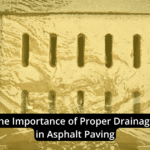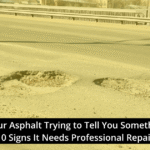
- Crumbling and missing chunks of concrete – If you notice holes and crumbling in your concrete surface, it’s usually an indication that the pavement is severely damaged. Once holes form, the concrete and sublayer will be exposed to weather, and that will weaken the surface even more. You can ask your paving contractor to patch holes in concrete, but these repairs rarely last long. When there are missing chunks of concrete and crumbling around the edges of those holes, it’s typically an indication that the surface needs to be replaced.
- Large cracks – Almost any paved surface eventually forms cracks. And while it’s true that small superficial cracks can usually be easily repaired, those that are deeper and create gaps of a half inch or more on the surface will almost always lead to more extensive damage. If your pavement has large, deep cracks that have created crevices, you may need to replace the surface altogether.
- Depressions in the surface – Concrete pavement is only as strong as the land beneath it. If the ground under your paved surface begins to shift or sink, you’ll likely see sunken areas form on the top. This is an indication that the ground underneath needs to be strengthened and leveled. Typically, this can only be done by removing the concrete on top, using a combination of sand and crushed stone to stabilize the soil, then replacing the concrete that was removed to make the repairs.
- Lots of repairs on old pavement – While it’s true that concrete is remarkably strong, pavement only lasts for so many years. If you have an older concrete surface, and you find yourself having to make extensive repairs over and over again, it might be time to replace the concrete completely.
To find out more about concrete repairs and replacement, contact a local reputable paving contractor. They can visit your site, assess the condition of your concrete, and tell you whether it will need to be replaced or repaired.






